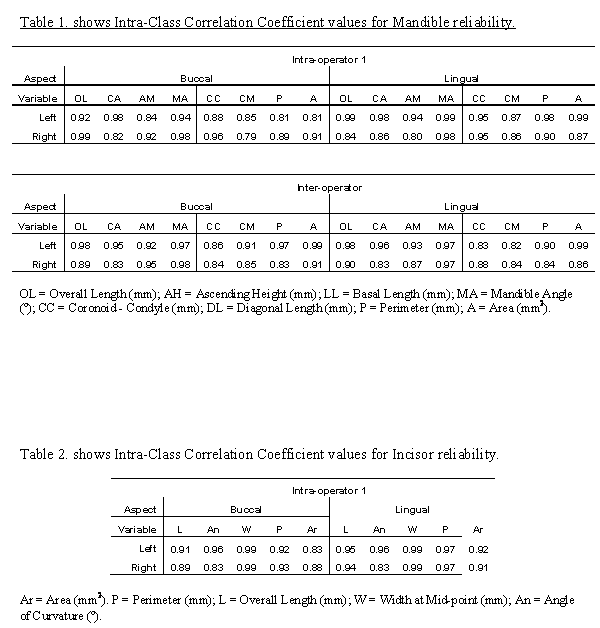ABSTRACT: 2071
Morphometric macro measurement of murine mandibles and incisors
| T.L. COXON, J.H. HIBBARD, A.H. BROOK, and R.N. SMITH, International Collaborating Centre in Oro-facial Genetics and Development, School of Dentistry, University of Liverpool, United Kingdom | |
Objectives: To demonstrate 2D image analysis techniques can be applied to investigate anomalies of size and shape through objective phenotyping of murine mandibles and mandibular incisors. To determine the reliability of these new morphometric variables for exploring important genotype-phenotype relationships of X-linked Amelogenesis imperfecta (X-AI). Methods: Twenty left and right CD-1 Wild-Type murine mandibles and mandibular incisors were extracted from 20 mice, at less than 22 weeks-old, to serve as a control population. Standardised images were taken from the buccal and lingual aspects by 2 independent operators. Images were captured using an established image analysis system with a 13.5 mega-pixel Kodak/ Canon DCS/n SLR digital camera mounted on a Kaiser photographic stand with a black matt background. All images were taken under uniform conditions of illumination, orientation and magnification, and included a 5mm linear scale. Calibrated repeat images and measurements were taken after a minimum interval of 24 hours. Morphometric variables of size, shape curvature and bulk were defined for the mandible (overall-length, ascending-height, basal-length, mandible-angle, coronoid-coronoid, diagonal-length, mandible-area, mandible-perimeter) and incisor (overall-length, angle-of-curvature, width-at-midpoint, incisor-perimeter and incisor-area) using Image Pro Plus 5.1 software. Results: Intra-Class Correlation Coefficients (ICCC) for intra-operator repeatability (≥0.79) and inter-operator reproducibility (≥0.82) represented good and excellent reliability for all variables (see Tables 1 & 2.). The ICCC for incisor reproducibility are also expected to be good or excellent. Conclusions: The study validated the application of standardised image analysis techniques for the morphometric assessment of murine mandibles and incisors, displaying a high degree of operator reliability. The new quantitative variables were practical, objective and provided additional information to facilitate genotype-phenotype analysis of X-AI. Further investigation with this model system will extrapolate an increased understanding of X-AI aetiology. Sponsored by the Wellcome Trust Foundation. Grant number GRO75945MA
| |
| Seq #205 - Hard Tissue Physical Properties 2:00 PM-3:15 PM, Friday, July 4, 2008 Metro Toronto Convention Centre Exhibit Hall D-E | |
©Copyright 2008 American Association for Dental Research. All Rights Reserved.
